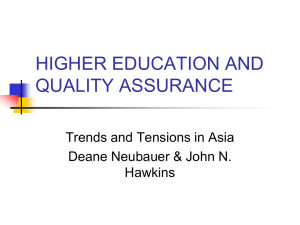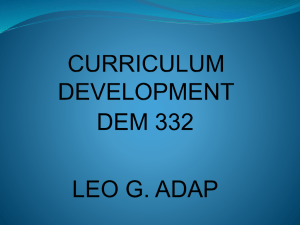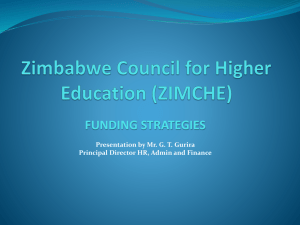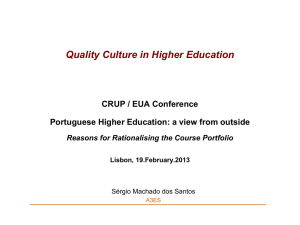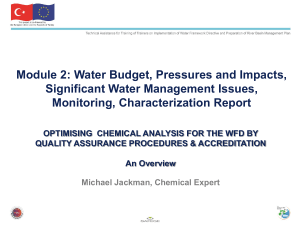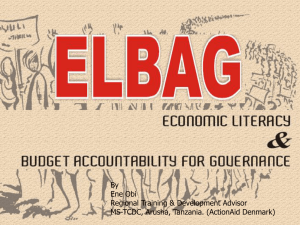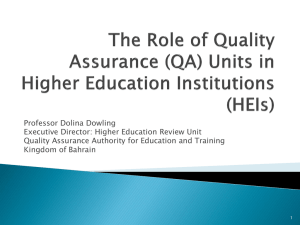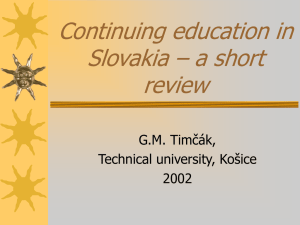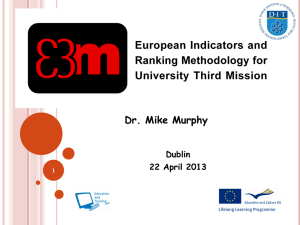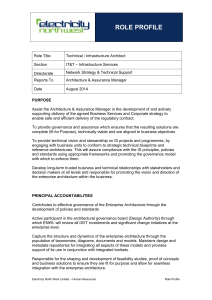Higher Education Reform in Albania
advertisement
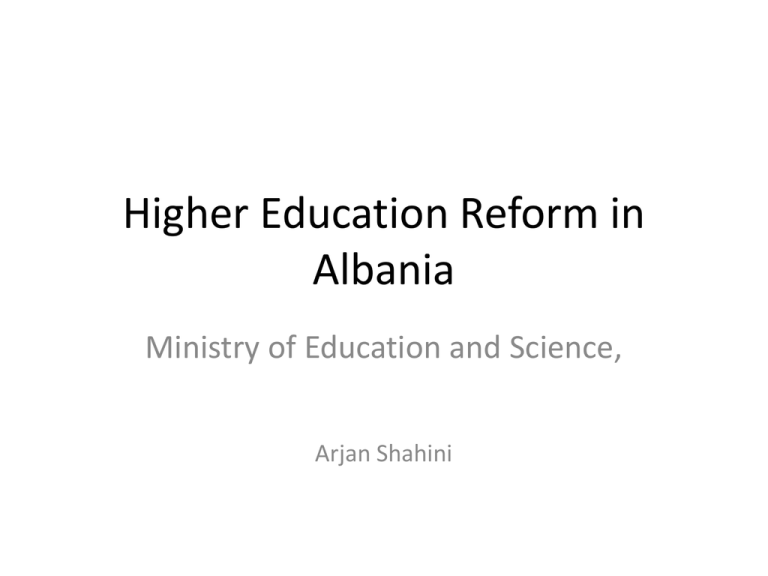
Higher Education Reform in Albania Ministry of Education and Science, Arjan Shahini Outline • Public Management: Central Authorities • Priorities (Gov. National Strategy for Higher Education 2008-13) • Expansion: Example Private Education (approach + current state) Central Authorities I. Public management and governance of higher education Central Authorities: - Government / MoES - Accred. Council - Council of Higher Education and Research - National Examination Center + Immatriculation - Parliament - Committee on Education and Means of Public Information - the Committee on Work, Social Issues and Health Objectives of the strategy • Develop the society and promote democratic standards. • Develop economically and equally the country through education of a qualified work force. • Fulfill the development aspirations of the young generations. • Develop and consolidate a wide and adequate knowledge base for the benefit of the country. Strategic priorities I. Expand the system (increase supply) meet the needs of the country and create higher education opportunities for all . II. Ensure diversity in education offers in line with the requirements of the future development of the country. III. Improve the quality of teaching and learning continuous training of human resources and fostering a culture of quality. IV. Improve governance mechanisms grant HEIs adequate autonomy conditional upon the achievement of quality management, accountability and transparency. V. Develop methods, schemes and levels of financing student’s based (need and merit – SL) for teaching and competitive for research institutions (SDF). Approach: Reform & Innovation Main Areas of Reform • • • • • • Learning Teaching Modernization Mobility Labor market Life-long Curriculum • Diversified • Tuition fees • Loans Funding •Accountability •Autonomy •Strategic partnerships •Quality assurance •Modernize •Management •Equal access •Internationalization Governance •Reg. Dev. Centers •Research Institution •Merge teaching & research Research & Development Strategy Evaluation: Problems 1. 2. 3. 4. 4. 5. 6. 7. Increase in environment’s complexity Resistance to change Difficulty predicting future Increasing number of variables Rate of obsolescence of plans National and global events Decreasing time span for planning certainty Lack of capacities for the implementation II. Expansion: Instruments • Liberalization of the education market: allow private providers (profit and non-profit). • Increase capacities (“consolidation and growth of the capacities of the existing institutions”) • Concentrated only in some fields of study (economic priority sectors: tourism, agricultural, food industry). • Gradual increase of the number of students. • Support regional universities II. Expansion: e.g private education (a) • Approach: – Mix: Laissez –faire with market competition* • • • • • No funding; tax incentives for students Private sector free to set tuition fees Limited regulation, but regular auditing No special laws state introduces market elements in the higher education market • creates open market structure • state encourage private-public competition * Zumeta W. (1997) State Policy and private Higher Education: Past, Present and Future. In: J. Smart (ed) Higher Education Handbook of Theory and Research. Volume XII. New York: Agathon Press: 43-106 II. Expansion – Private Education (b) • Policies - Introduction of market elements (marketization) in the education system Permissive policy for private providers to enter the market (licensure procedure) Substitute funds and / public funding (in the future!) • Results – Increase in private education institutions (46 by 2012) – Profilization of higher education institutions (study programs, professional colleges). – Increase in enrollment in private education (23 500 by 2011). • Consequences – Few elite HEIs – Public universities are more selective than private (due to state matura exam) – Private might go bankrupt or merge II. Expansion: Categories of private HEIs Private HEIs Elite Non-elite Identity Demand absorbing Elite For-Profit Semi-elite II. Expansion: Improve quality • Accreditation & quality assurance (new quality standards & benchmarks) • Inform the students about the quality of the supply (Ranking) • Encourage the establishment of professional colleges (less restrictive licensing procedure) • Prepare students of secondary level for the university (2+2 obligatory state examination) • Obligatory certificate in English for the masterlevel (law) • Internationalize the HEIs Private Education II • Quality Assurance – – – – – Accreditation Agency Accreditation Council Ministry of Education and Science State Standards of Evaluation and Accreditation Yearly monitoring / inspection • Informing students about the quality: Ranking! – CHE – Methodology: Multidimensional – Results I. Expansion: Improve quality • Accreditation & quality assurance (new quality standards & benchmarks) • Inform the students about the quality of the supply (Ranking) • Encourage the establishment of professional colleges (less restrictive licensing procedure) • Prepare students of secondary level for the university (2+2 obligatory state examination) • Obligatory certificate in English for the masterlevel (law) • Internationalize the HEIs II. Curriculum Reform • Evaluate the implementation of Bologna Standards • Follow the Bologna Process: 3-cycle system; • Competence based learning; • Flexible learning paths; • Recognition & mobility (internationalize curricula) • Adapt/restructure content, structure, teaching methods and materials; • Establish joint study programmes; • Establish links with the labour market (two year vocational schooling/college). III. Governance • Increase the autonomy of universities • Modernise the capacity, management and governance of higher education institutions and at the Ministry. • Management of students’ services • Build strategic partnerships, international and domestic relations with the private und state actors etc. • Ensure the quality of education (QA) • Promote a quality assurance culture • Increase accountability (toward government and the public) • Ensure equality and transparency in accessing the higher education III. Governance: Accountability • • • • Appointment (government or board) Representation (internal + external) Financial accountability (budget) Differentiated functions between academics and executives. • Performance – (reporting + monitoring + ranking + accreditation) • Responsiveness toward market needs IV. Research and Development: Strategy and Instruments • Document: National Strategy of Science, Technology and Innovation, 2009 • Integration of the research institutes in the higher education system • Innovation (applied research) • Establishment of interdisciplinary centers (Technology Transfer Centers and Agencies) • Assist in the development of the local community and businesses • Set up networks of cooperation with the most important industries • Share costs with the private sector and attract funds from international research programs. • Raise public awareness • Achieve excellence in the priority areas of development (agro-food and tourism)
